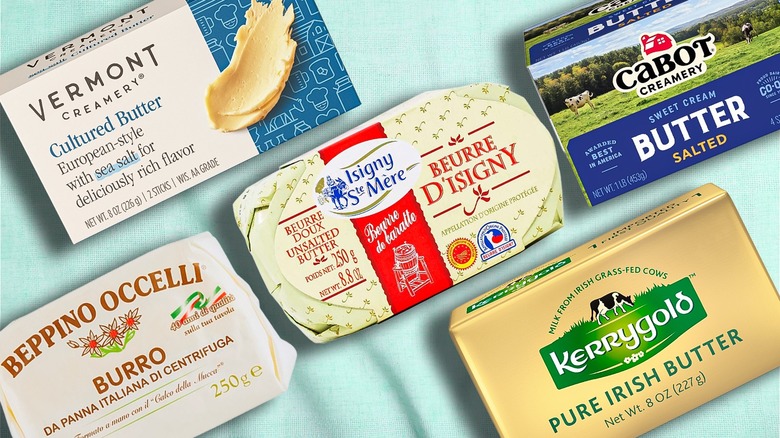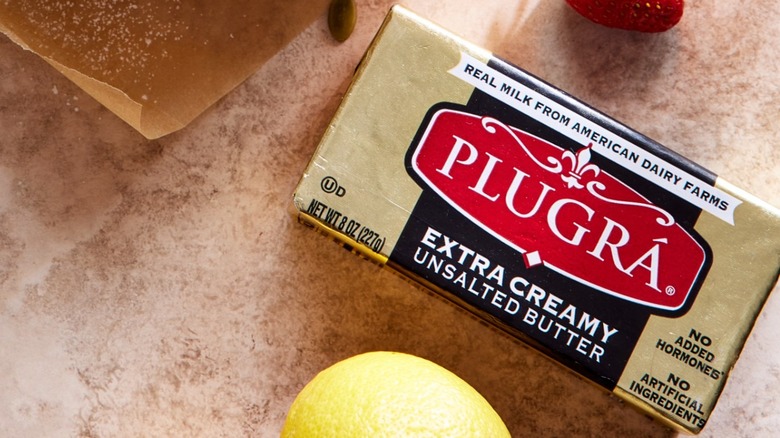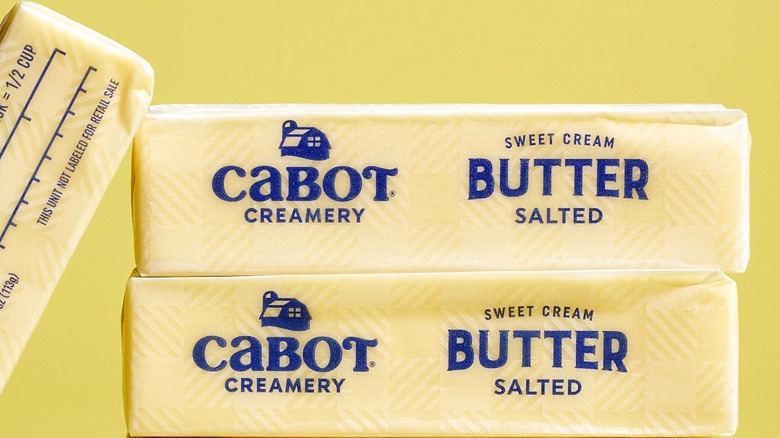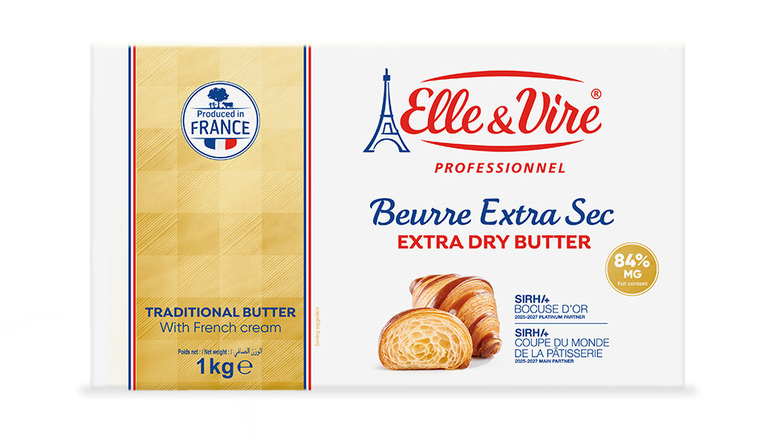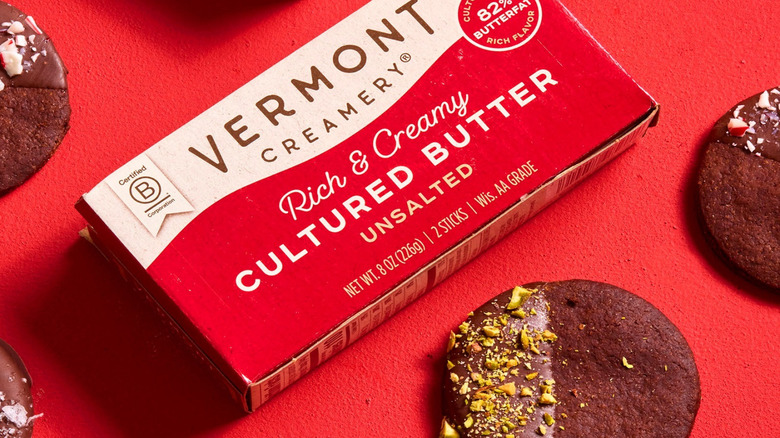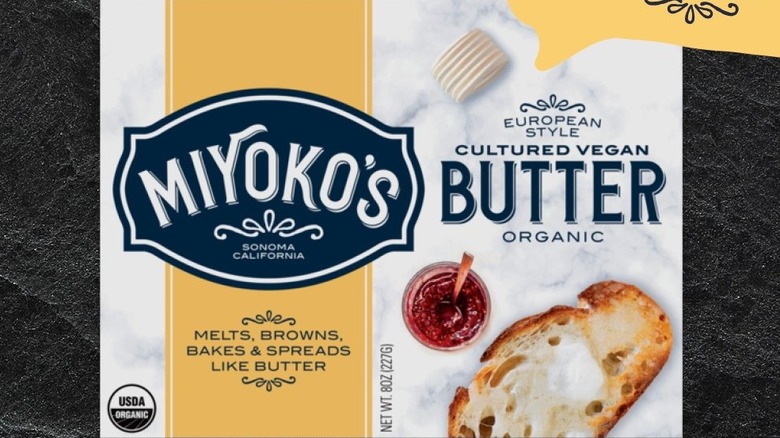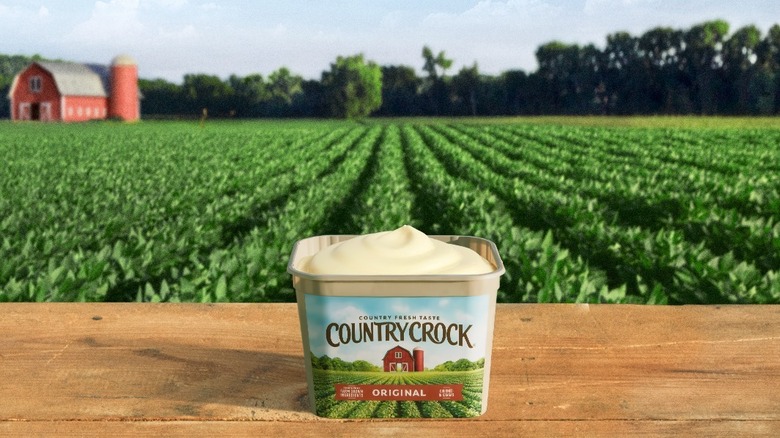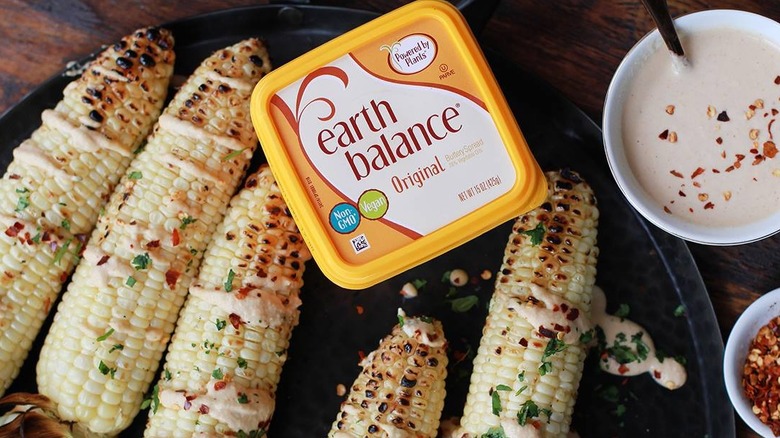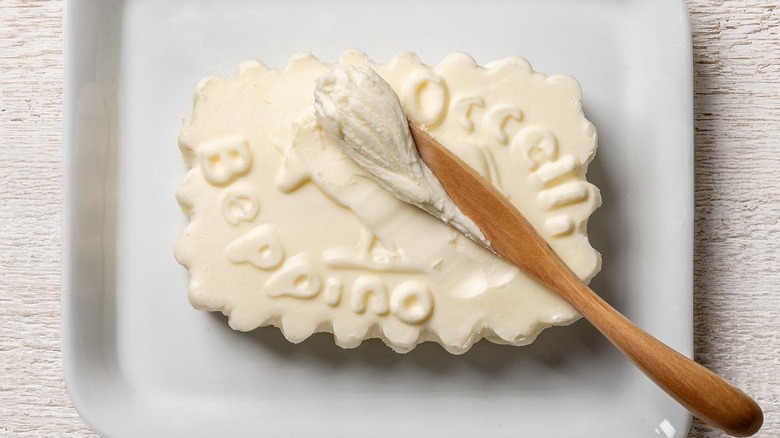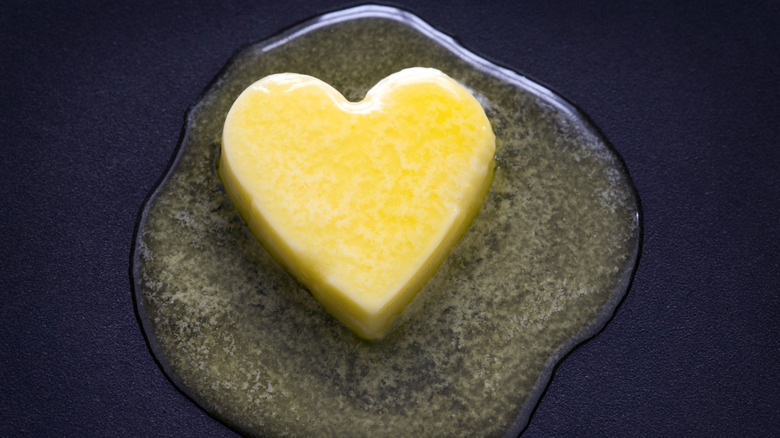The Best Butter Brands, According To Professional Bakers
When it comes to understanding the nuances of the role of great butter in baking, we turned to the people who understand it best: professional pastry chefs who handle butter every single day. In this deep dive into the world of butter, we aren't just looking for one superior brand. Instead, we are trying to understand how factors like water content, flavor, and butterfat ratios affect the quality of different baked goods. What works for a brioche will not work for a cookie, and the right butter depends on your plans to use it for (we will get into our methodology at the end of the article).
For this comprehensive list, we approached a few experts in the field. Chef Becky Geisel, a self-taught force, runs BEX, a lifestyle food company celebrated for its fresh, simple, whole-food philosophy. Chef Antonello Ghessa of Zeppola Cafe and Zeppola Bakery brings an authentic Italian sensibility to shape some of Las Vegas and New York's most beloved pastries. Meanwhile, chef Odette D'Aniello helms celebrated brands Celebrity Cake Studio and Dragonfly Cakes, while also hosting the Celebrity Gourmet Podcast. Rounding out the panel is chef Tony Park of Angelina Bakery, whose Manhattan sweet stop marries the warmth of his family's recipes with an Italian bakery experience.
Together, these experts offer their collective input on what makes some butter brands shine and others flop, and how to best use each (including some vegan and plant-based standouts) to ensure the ideal results.
Plugrá (USA)
Plugrá has quietly earned a reputation as the American butter you can depend on. Made by the Dairy Farmers of America cooperative in small batches that are slow churned, this butter also stands out with its 82% fat content. Both chef Becky Geisel of Bex Kitchen and chef Tony Park of Angelina Bakery praise Plugrá for its balance of flavor and consistency. "In my kitchen, butter choice makes the biggest difference in croissants and puff pastry — it affects everything from the lift to the aroma when they come out of the oven," says Geisel.
Chef Tony Park, whose croissants and financiers are a New York favorite, also leans on Plugrá for its versatility. "I might use a rich, cultured butter like Plugrá or Kerrygold for flavor-heavy items such as cookies or financiers," he explains. While definitely on the pricier side than most other butters on the market, if you are a home baker with a yen for a rough puff pastry that oozes buttery richness without the hard work, then Plugrá offers the ideal professional shortcut.
Président (France)
If you are one of those bakers who only put their faith in French butter, then Président is the gold-standard you should reach for. Known for its depth of flavor and stable 82% fat content, Président delivers both the structure and consistency that laminated doughs demand. Chef Becky Geisel swears by it for her croissants and puff pastry menu: "For those, I reach for Plugrá or Président, both European-style with a cultured flavor and consistent 82% butterfat."
When it comes to lamination, precision is the name of the game, and the way butter behaves under high temperatures can determine if your pastry rises or flops. On this front, we can safely say that Président holds its shape through all the tests thrown at it. Chef Tony Park often alternates brands depending on the bake, but explains, "I ... switch to a more stable butter like Beurre d'Isigny Sainte-Mère or Président Professionnel ExtraDry for croissants." For chefs who demand consistency service after service, Président remains the butter that holds everything together — from extravagant mille-feuilles to classic sablés.
Kerrygold (Ireland)
The iconic gold tub of Ireland's dairy export, Kerrygold butter remains the darling of both professional and home bakers. Chefs appreciate its nutty, sweet flavor that is the direct result of grass-fed cows. Kerrygold butter is proof that terroir applies to dairy as much as it does to wine. When the pastures are lush, the livestock's diet produces milk higher in beta-carotene, creating a delicious, aromatic, naturally golden butter. Chef Becky Geisel swears by it for the richness it lends to doughs and batters: "Kerrygold's grass-fed butter adds a golden hue and rich flavor." Chef Tony Park agrees, describing it as "flavor-forward, slightly nutty — great for sablés and biscuits."
With its high fat content, this butter tends to be softer at room temperature. For bakers, this means that Kerrygold performs best in recipes that don't demand precision or rise like croissants. It is ideal for bakes with a slightly higher moisture content and softer texture that allow the richness to shine through. And if you are a home chef who has always wanted to recreate the lush mouthfeel of restaurant butter, Kerrygold is your secret weapon.
Cabot (USA)
Not all butters have the glamor of French brands, but in a chef's kitchen, what really matters is consistency. Here's where American-branded Cabot Creamery butter wins over bakers and proves its worth. Don't just listen to us, this butter is also a staple in Ina Garten's kitchen! From creamy cookie batter and light-as-air frostings to smooth cake mixes, Cabot's dependability comes in handy when you need everything to work exactly as it should. Chef Becky Geisel captures this perfectly: "When baking cookies or cakes ... Cabot offers a dependable texture that blends beautifully into doughs and batters."
Its reliability comes from the butter's uniform fat content and its ability to emulsify smoothly. For bakers in the know, these are two factors that make a world of difference in professional kitchens. Unlike highly cultured European butters, Cabot's flavors are cleaner and more neutral. This allows other ingredients to take the spotlight without any overpowering aroma. Cabot can be considered a middle-ground product thanks to its accessibility in terms of price and availability, bridging the gap between grocery-shelf convenience and pastry-grade precision.
Isigny Sainte-Mère (France)
Ask a pastry professional about the gold standard of butter, and odds are that Isigny Sainte-Mère will come up in the conversation. This Normandy-made butter is the go-to for chefs looking for perfect lamination. Chef Tony Park puts it simply: "For laminated doughs, I use extra dry, high-fat European butter like Isigny Sainte-Mère ... unmatched for croissants, puff pastry, and viennoiserie. Buttery aroma, low moisture, and superb plasticity."
The word plasticity explains everything you need to know about Isigny Sainte-Mère. It's the reason for its legendary status, and refers to how the butter behaves under pressure and temperature. If butter is too firm, it cracks through the dough while rolling. On the other hand, when it's too soft, it melts, and the layers collapse. Isigny's ideal fat-to-water ratio (around 82% butterfat with minimal added water) and slow culturing process are what cause it to act so reliably. And then there's the flavor to consider. When the milk comes from Normandy's lush coastal pastures, the result can only be an appealing pale golden butter with a subtle sweetness and a multilayered aroma that perfumes any kitchen as the pastries bake.
Elle & Vire Professionnel (France)
Pastry chefs clamor for Elle & Vire butter for several reasons — prime among them is its engineering. With a butterfat content ranging between 80 to 82%, this translates to technical excellence and dependability in the baking world. Chef Tony Park explains when he chooses Elle & Vire: "For laminated doughs, I use extra-dry, high-fat European butter like Isigny Sainte-Mère or Elle & Vire Professionnel." He further explains that butter is key to the results. "The wrong butter either leaks or fails to laminate cleanly. A high-fat, low-moisture butter gives sharp, clean layers, while a regular supermarket butter can collapse the whole structure. The flavor and aroma when the pastry comes out of the oven are worlds apart depending on the butter used," he says.
The professional formula is created specifically for pastry, with a low moisture content that minimizes steam and prevents distortion during baking. Additionally, Elle & Vire's uniform plasticity (the way it bends without breaking or melting) ensures a clean and even rise on all baked goods. When it comes to flavor profile, this butter remains intentionally neutral, which is perfect when you want the dough's fermentation and individual character to shine through.
Vermont Creamery (USA)
For chef Tony Park, "Vermont Creamery makes a beautiful cultured butter — amazing for shortbreads and tarts." Numerous professionals and celebrities like Martha Stewart have already taken notice of this butter and its depth of flavor. With a distinct, tangy aroma and a rich mouthfeel, Vermont Creamery has succeeded in creating a butter that provides bakers with the supple, velvety consistency they crave. As chef Antonello Ghessa reminds us, "think fat for flavor and moisture for 'lift.' If there isn't proper balance, the finished product can be too brittle or leaky."
What makes Vermont Creamery butter stand out is its culturing process, detailed on the website. Unlike the regular sweet cream butter made in the rest of the country, this butter begins by adding live bacterial cultures to cream. Much like the process of grape fermentation to create wine, cultured butter develops a wonderful tangy flavor as it rests and thickens. Once churned, the result is a butter with a slightly higher acidity and notes of hazelnut and buttermilk. This is why it shines in recipes like shortbreads, sablés, and tart doughs, where texture and aroma are everything.
Miyoko's European Style Cultured Vegan Butter (USA)
If you have been struggling with finding alternative ingredients to turn your vegan desserts into decadent treats, look no further than Miyoko's European Style Cultured Vegan Butter. Chef Odette D'Aniello sums it up perfectly: "For plant-based baking, I like using Miyoko's European Style Cultured Vegan Butter ... I love this one for its flavor; it mimics the complexity of cultured dairy butter and adds richness to shortbreads and frostings."
Quietly amassing a loyal following among home chefs and professional bakers, Miyoko's butter uses cashew milk and coconut oil instead of cream. Borrowing from the same European process of adding live cultures to ferment the base, the butter is then churned to replicate a distinctive cultured tang and gentle depth of flavor. Miyoko's high fat percentage and moisture content make it the perfect vehicle for all sorts of doughs, batters, and buttercreams. Founded by Miyoko Schinner, a pioneer in plant-based dairy, it redefines what vegan pastries can taste like and offers proof that plant-based fats can deliver the same warmth and soul as dairy butter. Dare we say, even with a bit more personality?
Country Crock Plant Butter (USA)
Chef Odette D'Aniello explains the struggles about baking with vegan butter: "Vegan butters can vary widely because some are coconut-oil-based and melt too quickly, while others, like Miyoko's or Country Crock Plant Butter, hold up beautifully." For her, Country Crock Plant Butter with olive oil is a go-to for creaming and buttercreams. As she explains, "For cakes and buttercreams, consistency matters more than terroir. Even vegan butters can create luscious, rich layers if you balance the moisture and fat content properly."
Many plant-based butters use a significantly higher ratio of coconut oil, which can melt too fast and prevent proper emulsification. Country Crock takes a more balanced approach by successfully blending plant oils, such as olive and canola, to mimic the fat composition of butter. When used in cookies and cakes, this vegan alternative adds tenderness while complementing the recipe's sweetness. Country Crock may not carry the cultured tang of premium European butters, but in terms of consistency and stability, there is no compromise.
Earth Balance (USA)
For many bakers, Earth Balance butter represents more than just a tasty plant-based alternative. Chef Odette D'Aniello explains, "It's allergy-friendly, consistent, and works beautifully in everything from buttercream to cookies." Earth Balance is one of the most versatile products, made from a carefully balanced blend of vegetable oils (typically canola, palm fruit, soybean, and flaxseed). Its moderate melting point produces smooth, creamy batters that resist curdling, and its moisture content works particularly well when baking cookies and cakes. But what truly makes Earth Balance butter special is that it's dairy-free and lactose-free, making it an ideal ingredient for the modern baker who needs to cook for a wide variety of audiences.
D'Aniello also notes that the key to choosing the best vegan butter for your baking is a close inspection of the ingredients. She recommends not simply focusing on the fat percentage but also noting factors such as color, aroma, and texture. If you want to train your palate, she recommends spreading different types of butters on plain crackers or warm toast and noticing the finish. Do they taste clean and buttery, or do they leave a film? That exercise alone can change how you choose butter for baking.
Beppino Occelli (Italy)
Among pastry chefs, Beppino Occelli butter is revered and respected. Chef Antonello Ghessa describes it simply as "an artisanal Italian butter prized for flavor." But, make no mistake, this is not butter that you reach for every day. Rather, Beppino is brought out when taste matters above all else. Made in the rolling green hills of Piedmont, Beppino Occelli butter is hand-churned in small batches and made from the milk of mountain cows. The terroir of the pastures translates directly into the butter's flavor, which carries traces of nuttiness, a natural sweetness, and its iconic lightly floral aroma. Each butter is then wrapped by hand and aged briefly, allowing it to develop its complex tang.
When asked if European-style butters actually lead to better results, chef Tony Park commented, "Yes, but only if the recipe supports it. The higher fat and lower water give superior flakiness and more depth of flavor in laminated pastries. The cultured tang adds complexity; you taste it in a kouign amann or sablé breton. But for delicate sponge cakes or meringue-based desserts, that same cultured flavor can be distracting."
Bordier (France)
French butter really makes a difference. There, we said it. Whether you are a professional baker or a novice home chef, there is no denying that baking with French butter changes the game entirely. Chef Antonello Ghessa sums it up with unfiltered passion: "Butter is the sensory experience. You can replace sugar, vanilla, flour and no one will bat an eye, but if you replace butter, fuhgeddaboutdit!"
And for many chefs, Bordier is that irreplaceable butter. As chef Tony Park elaborates, "Butter is the soul of pastry. It defines the color (that golden tone), the aroma that fills the kitchen, and the mouthfeel, the difference between greasy and silky. A great butter leaves a clean finish and a lingering dairy sweetness, not an oily residue. It's what makes people close their eyes when they take that first bite."
With dairy sourced from Brittany, Normandy, and the Loire, this magnificent product is still kneaded and shaped by hand at the Maison Bordier workshop, defining what true luxury tastes like. The company produces various types of butters for different occasions. For example, the French use one butter for baking and another for daily use or for spreading on bread.
Bonus Mentions
Not every great butter fits neatly into a category. These bonus picks from our chefs include butters that need a mention, irrespective. Chef Antonello Ghessa, for example, swears by Ferrarini butter from Italy. He chooses it for its flavor even when eaten plain (and of course for its impressive stability when baking). Across the Atlantic in the U.S., Tillamook butter earns chef Odette D'Aniello's vote as her go-to salted butter for the subtle layers of flavor and the natural balance it adds to sweet or chocolatey bakes. Many chefs prefer using salted butter for their baked goods, as salt enhances sweetness and adds a welcome depth to desserts like brownies, tarts, and ganaches.
When it comes to choosing the best butters, chef Tony Park notes that every detail matters. "Start by checking the fat percentage, aim for 82% or higher. Then notice the color and aroma: deeper yellow often means grass-fed, which gives richer flavor. When left at room temperature, the butter should soften evenly, not separate or pool water." His final tip is to test the butter yourself. Bake the same cookie recipe with two brands of butter and compare the aroma, color, and texture. You will quickly discover that butter is so much more than just another ingredient, but rather the foundation of the recipe.
How we chose the butters
Any pastry chef will tell you — it's never about a single best butter. Butter behaves differently depending on what you are baking or cooking, and the right choice is usually determined by purpose rather than reputation. So, rather than ranking by preference or popularity, these butters made it to the list according to how and when professional chefs actually use them in their kitchens. As chef Antonello Ghessa sums up, "There is no balance. I go between butter that tastes great cold on a plate and butter that is sturdy and reliable in the oven."
Each brand earned its place because of a specific strength. We see Plugrá make an appearance for its reliability in laminated doughs, Kerrygold for flavor and color, Isigny Sainte-Mère for its history and flawless rise, and Miyoko's for plant-based experimentation. When it comes to baking, butter is never a one-size-fits-all ingredient but a means to an end, and more often than not, the secret that separates a good bake from a great one.
